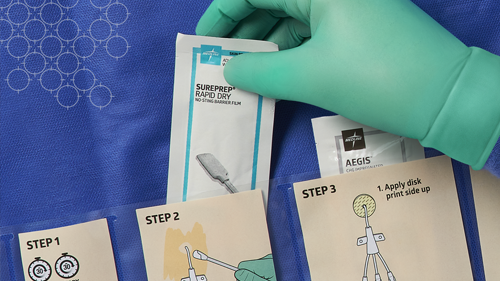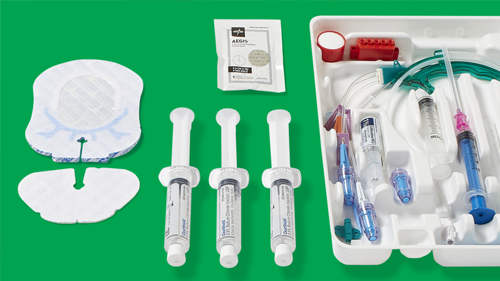Can your travel nurses do a central line dressing change?
4 target areas for preventing CLABSI during hospital staffing shortages.

You’re probably wondering: When will this nursing shortage end? Unfortunately, it doesn’t look to be anytime soon. By 2025, the United States may have a gap of 200,000 to 450,000 nurses available for direct patient care—a 10 to 20% gap.1
Those numbers don’t change your priority of high-quality patient care. That care includes preventing healthcare-associated infections (HAIs) such as central line associated bloodstream infections (CLABSIs). You need your new hires and travel nurses to understand the importance and adopt your facility’s clinical practices quickly. But how?
It starts with making sure a central line maintenance bundle is part of your protocols and processes. Then you’ll be able to assess the knowledge of new arrivals and target their education. Here’s how.
Start with the screening process
Whether you or an agency screens travel nurses for placement, make sure the following bases are covered:
Background checks: Conduct thorough background checks, including verifying the travel nurse’s employment history, checking for any criminal records or license sanctions, and reviewing their education and training.
References: Contact the travel nurse’s references to gain insight into their past performance, work ethic and overall professionalism. It’s important to ask specific questions related to infection prevention and control, such as their experience with central line care and their knowledge of CLABSI prevention strategies.
Interview questions: Ask targeted interview questions to help screen for travel nurses who have experience with infection prevention and control. For example, you might ask them to describe their experience with central line care or how they would handle a situation where a patient developed a CLABSI.
Certifications and licenses: Make sure to verify that travel nurses hold the necessary certifications and licenses to practice in their state and specialty area. And find out if they have additional certifications such as the Certification in Infection Prevention and Control (CIC).
Send pre-work and kick-start orientation
You can assess travel nurses’ knowledge and start the orientation process before their first day:
Provide pre-employment materials: Give travel nurses materials such as policies and procedures, employee handbooks and information about the healthcare facility’s culture and mission. These materials can help familiarize the travel nurse with the healthcare facility and its expectations.
Provide orientation materials: Help travel nurses get started with orientation materials such as a handbook or a virtual tour of the facility. This can help them get a sense of the facility’s layout and culture.
Offer virtual onboarding sessions: Virtual onboarding sessions can be conducted via video conferencing tools to introduce the travel nurse to the healthcare facility. These sessions can also provide an opportunity for them to ask questions and connect with other staff members.
Provide access to online training modules: Give travel nurses access to online training modules related to CLABSI prevention, hand hygiene, aseptic technique and other infection prevention practices. These modules can be completed before the nurse’s first day on the job.
If it’s not possible to provide online training, consider partnering with your medical supplier. Some companies offer free remote learning opportunities, and many of the courses count for continuing education credit.
“When travel nurses are able to complete some educational training before their first day, it frees up time for more specific orientation in a limited amount of time,” says Donna Matocha, DNP, MSN, VA-BC, Medline Manager of Clinical Resources—Acute Care.
Up to 70% of CLABSIs
can be prevented by implementing evidence-based practices2
Connect them with a mentor: Consider assigning a mentor to the travel nurse before their first day on the job. The mentor can provide guidance and answer questions about the healthcare facility and its practices.
Launch onboarding measures
It’s your travel nurses’ first day. Time to drive home what they learned in their pre-work.
Continue orientation and training: Make sure they understand the policies and procedures related to infection prevention. The nurses are now familiar with the concepts of proper central line maintenance. Consider providing hands-on training and assessments to verify competency.
Review data on CLABSIs: Share data on past CLABSIs and your facility’s performance in reducing CLABSIs to help travel nurses understand the importance of their role in preventing infections. “Here’s where you can emphasize your facility’s process and why it’s important for the travel nurse to adopt it,” says Matocha. “Practice variability increases infection risk.”
Provide access to resources: Ensure all nurses have access to relevant policies and procedures, infection prevention resources and clinical guidelines. This can include links to online resources, laminated guides to hang on their ID badges and phone numbers for infection prevention staff.
Foster a culture of infection prevention: Does your facility highlight the importance of infection prevention? Consider displaying posters and reminders in clinical areas, offering continuing education on infection prevention and providing recognition for staff who contribute to reducing CLABSIs.
Provide ongoing education and training in multiple formats
Keep it coming. The more nurses know, the better they can help prevent HAIs. Using a variety of teaching methods can help with engagement and retention. Consider:
Classroom training: Lecture-style presentations or interactive discussions led by a trainer or subject matter expert can cover a wide range of topics related to CLABSI prevention, such as central line dressing changes and securement.
Hands-on training: Travel nurses can practice and demonstrate their skills in a clinical setting. This can include demonstrations by a trainer, one-on-one instruction, bedside peer-to-peer observation, or simulation scenarios using manikins or other training tools.
Online training: This format can be a convenient and cost-effective way to provide education to travel nurses. These modules can be completed on nurses’ own time and can include interactive components such as quizzes or simulations.
Competency assessments: Enable travel nurses to demonstrate their knowledge and skills in a clinical setting through written exams, skills checklists, and/or observed clinical simulations.
Again, if you don’t have the resources to provide these opportunities, consider taking advantage of what a medical supplier can offer: product education, in-service training, videos and modules, and continuing education.
Emphasize your facility’s process and why it’s important for the travel nurse to adopt it. Practice variability increases infection risk.

Donna Matocha, DNP, MSN, VA-BC
Medline Manager of Clinical Resources—Acute Care
Encourage open, honest communication
Do staff feel empowered to speak up?
Promote a “just culture”: “This means that if someone reports a mistake they made, they won’t be punished for it,” says Matocha. “Because they may not know something, and you don’t want them to hide it.”
That drives learning and helps identify opportunities for improvement that ultimately will reduce errors, she adds.
Monitor and report on CLABSI rates: It’s important to track these HAIs and provide regular updates to travel nurses and other staff members. This can help keep travel nurses informed about the impact of their efforts on infection prevention.
Provide feedback and support: Let travel nurses know how they’re doing in their CLABSI prevention efforts. This can include providing data on CLABSI rates, identifying areas for improvement and offering guidance on best practices.
Key takeaway
It’s not easy to get travel nurses up to speed when you’re already short-staffed. If you start the assessment and education process before a nurse’s first day, build on competencies, provide ongoing education, encourage communication and make the most of your medical supplier partnership, you’ll be better positioned to get the whole nursing staff up to speed on CLABSI prevention.
References:
- Berlin, G., et al. (2022, May 11). Assessing the lingering impact of COVID-19 on the nursing workforce. McKinsey & Company. https://www.mckinsey.com/industries/healthcare/our-insights/assessing-the-lingering-impact-of-covid-19-on-the-nursing-workforce
- Jones, K. Maintenance and removal of central venous catheters. CDC. CLABSI 104 (cdc.gov)





